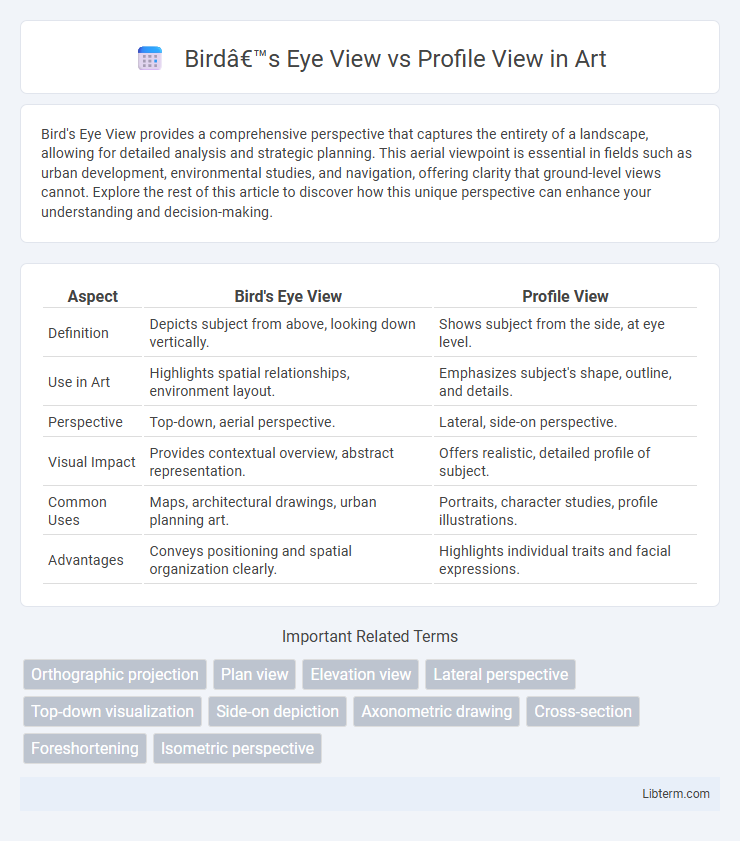Bird's Eye View provides a comprehensive perspective that captures the entirety of a landscape, allowing for detailed analysis and strategic planning. This aerial viewpoint is essential in fields such as urban development, environmental studies, and navigation, offering clarity that ground-level views cannot. Explore the rest of this article to discover how this unique perspective can enhance your understanding and decision-making.
Table of Comparison
| Aspect | Bird's Eye View | Profile View |
|---|---|---|
| Definition | Depicts subject from above, looking down vertically. | Shows subject from the side, at eye level. |
| Use in Art | Highlights spatial relationships, environment layout. | Emphasizes subject's shape, outline, and details. |
| Perspective | Top-down, aerial perspective. | Lateral, side-on perspective. |
| Visual Impact | Provides contextual overview, abstract representation. | Offers realistic, detailed profile of subject. |
| Common Uses | Maps, architectural drawings, urban planning art. | Portraits, character studies, profile illustrations. |
| Advantages | Conveys positioning and spatial organization clearly. | Highlights individual traits and facial expressions. |
Understanding Bird’s Eye View
Bird's Eye View provides a top-down perspective, enabling comprehensive spatial awareness and efficient navigation in map-related applications. This view captures the entire environment from above, highlighting relationships between objects and their surroundings. Understanding Bird's Eye View improves decision-making in urban planning, robotics, and gaming by offering a clear overview of spatial layouts and movement patterns.
Defining Profile View
Profile view, also known as side view, captures an object's vertical and horizontal dimensions from one side, highlighting height and depth without showing width. It contrasts with Bird's Eye View, which presents a top-down perspective emphasizing width and depth but omitting height. Understanding profile view is essential for detailed anatomical studies, architectural elevations, and character design in various visual and technical fields.
Key Differences Between Bird’s Eye and Profile Views
Bird's Eye View offers a top-down perspective that reveals spatial relationships and layout, ideal for mapping and navigation, while Profile View provides a side-on look emphasizing height, depth, and elevation changes, crucial for analyzing structures or terrain profiles. The Bird's Eye View captures broad context with minimal distortion, facilitating comprehensive area assessment, whereas the Profile View emphasizes vertical dimensions, making it suitable for measuring slopes and understanding structural features. Selecting between these views depends on the analytical needs: layout and positioning versus elevation and depth analysis.
Applications in Art and Design
Bird's Eye View offers a comprehensive spatial perspective, enabling artists and designers to create detailed layouts for urban planning, game design, and architectural visualization, emphasizing structure and spatial relationships. Profile View provides an essential side perspective crucial for character design, sculpture, and product modeling, highlighting form, proportion, and detail. Both viewpoints synergize in multimedia projects, allowing a multidimensional understanding that enhances visual storytelling and functional aesthetics.
Visualization in Architecture and Planning
Bird's Eye View in architecture and planning provides a comprehensive overhead visualization, enabling accurate spatial analysis and urban layout understanding. Profile View emphasizes vertical dimensions, crucial for evaluating building heights, facade designs, and elevation relationships within environments. These complementary visualization techniques enhance design precision and contextual awareness in architectural projects.
Impact on Geographic Mapping
Bird's Eye View provides a top-down perspective essential for accurate geographic mapping, allowing clear visualization of spatial relationships and terrain features. Profile View offers a side elevation perspective, crucial for understanding vertical dimensions such as elevations, slopes, and depth contours in geographic mapping. Combining these views enhances the accuracy and comprehensiveness of spatial data interpretation and terrain analysis.
Practical Uses in Photography
Bird's Eye View photography offers unique perspectives ideal for capturing landscapes, architecture, and spatial relationships, providing a comprehensive overview often used in aerial photography and real estate marketing. Profile View focuses on the side angle of subjects, commonly utilized in portrait photography and wildlife documentation to highlight shapes, textures, and expressions. Both perspectives enhance visual storytelling by emphasizing different spatial dimensions and subject details, crucial for creative compositions and effective communication.
Comparing Perspectives in Scientific Illustration
Bird's Eye View and Profile View offer distinct perspectives crucial in scientific illustration for accurately representing spatial relationships and anatomical details. Bird's Eye View provides a top-down perspective, enhancing understanding of layout, distribution, and environmental context, while Profile View presents a side-on angle that highlights structural features and vertical dimensions. Combining these views allows scientists to convey comprehensive information, facilitating clearer communication in research and education.
Choosing the Right View for Your Project
Selecting the appropriate perspective is crucial in architectural and design projects, with Bird's Eye View offering a comprehensive overview that highlights spatial relationships and site layout. Profile View emphasizes elevation and side details, ideal for structural analysis and facade design. Tailor the choice to project goals: use Bird's Eye View for planning and overall visualization, while Profile View suits detailed examination of height, siding, and textures.
Enhancing Communication with Visual Perspectives
Bird's Eye View offers a top-down perspective, enabling a comprehensive overview that facilitates spatial understanding and strategic planning in communication. Profile View provides a side-on angle that highlights height and depth, supporting detailed examination of structure and form to clarify complex concepts. Combining these visual perspectives enhances communication by catering to diverse cognitive styles, improving clarity and engagement in presentations or design discussions.
Bird’s Eye View Infographic

 libterm.com
libterm.com